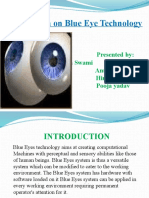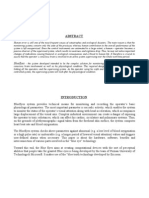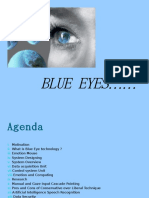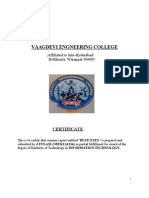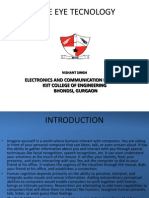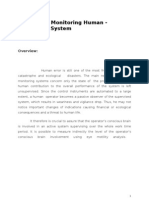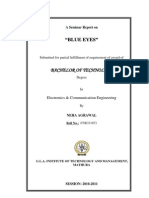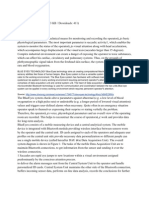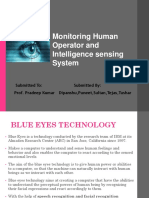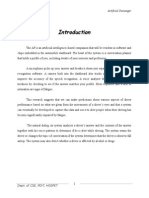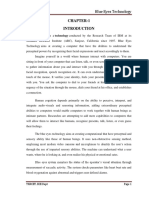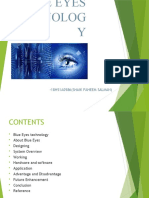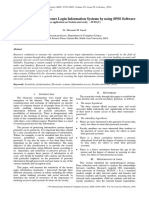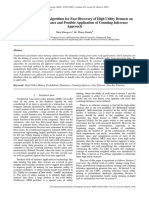The Blue Eyes Technology: Overview & Applications: Ntroduction
The Blue Eyes Technology: Overview & Applications: Ntroduction
Uploaded by
editorinchiefijcsCopyright:
Available Formats
The Blue Eyes Technology: Overview & Applications: Ntroduction
The Blue Eyes Technology: Overview & Applications: Ntroduction
Uploaded by
editorinchiefijcsOriginal Title
Copyright
Available Formats
Share this document
Did you find this document useful?
Is this content inappropriate?
Copyright:
Available Formats
The Blue Eyes Technology: Overview & Applications: Ntroduction
The Blue Eyes Technology: Overview & Applications: Ntroduction
Uploaded by
editorinchiefijcsCopyright:
Available Formats
International Journal of Computer Systems (ISSN: 2394-1065), Volume 03 Issue 03, March, 2016
Available at http://www.ijcsonline.com/
The Blue Eyes Technology: Overview & Applications
Abhinav Srivastava, Himanshu Patodia, Amit Garg, Manish Bhardwaj
Department of computer engineering
Poornima Institute of Engineering & Technology, Jaipur, India
Abstract
Imagine you wake up one day, turn on your pc and it says hello friend whats up!! That means you are sitting in opposite
of your personal computer that can listen, talk, or even yell aloud. It has the ability to collect information about you and
interact with you through special skills like facial recognition, language recognition, etc. It can even recognize your
emotions at the tad of the mouse. It authenticates your identity, feels your offerings, and begins interacting with you. You
ask the PC to dial to your friend at his workplace. It realizes the urgency of the state through the mouse, dials your friend
at his office, and launches a connection. The BLUE EYES technology objects at creating computational machines that
have perceptual and sensory capability like those of human beings. It uses sensing method, video cameras and
microphones to identify the users activities by using some intellectual abilities
Keywords: Blue Eyes, Data Acquisition Unit, Central System Unit, Sensors and Bluetooth.
I.
INTRODUCTION
The term Blue Eyes is a mixture of Blue and Eye.
Blue stands for Bluetooth, for dependable wireless
communication and the Eyes for the eye movement, which
permits to obtain fascinating and important information.
physiological constraints and an overall interpretation of
the operating room are recorded. This helps to restructure
the course of operators work and provides data for longstanding analysis.
Blue Eyes system offers technical means for observing
and recording human-operator's physiological situation.
The key characteristics of the system are:
Visual attention observing (eye motility examination)
Functional condition checking (pulse level, blood
oxygenation)
User's location acknowledgement (standing, lying)
Wireless data attainment using Bluetooth technology
Physiological data, operator's speech and overall view
of the control room recording.
Saved data rerun.
Real-time user-defined alarm prompting.
II.
METHODOLOGIES
This technology of BLUE EYES delivers a practical
means for detecting and recording the operators
elementary physiological parameters. The most significant
parameter is saccadic activity1 (Saccades are immediate
eye jumps to new locations inside a visual environment
allocated predominantly by the Sensible attention process.),
which empowers the system to monitor the status of the
operators optical attention along with head spurt, which
complements large displacement of the visual alignment
(saccades greater than 15 degrees).
Quite often in a crisis situation operators speak to
themselves conveying their surprise or stating orally the
problem. Therefore, the operators vocal sound,
Fig 1: Overall system diagram
Description of above Diagram- Mobile Data
Acquisition Unit sustain Bluetooth networks, acquires
information from the sensor and sends it above the wireless
connection, to provide the alarm messages propagated
through the Central System Unit to the operator and handle
made to order ID cards. Central System Unit conserves the
other side of the Bluetooth connection, cushions incoming
sensor data, accomplishes online data examination, records
the assumptions for additional investigation and provides
envisioning interface. The priority of the central unit is to
deliver real-time buffering of entering sensor signals and
semi-real-time dispensation of the data, which necessitates
speed optimized filtering and intellectual algorithms.
A. Data Acquisition Unit
(1) Physiological Data Sensor
An off-shelf eye movement measuring device-JAZZ
multi-sensor was used as functional data sensor. It
deliveries underdone digital data concerning eye position,
285 | International Journal of Computer Systems, ISSN-(2394-1065), Vol. 03, Issue 03, March, 2016
Abhinav Srivastava et al
The Blue Eyes Technology: Overview & Applications
the level of body fluid oxygenation, acceleration along
perpendicular and straight axes and ambient light
concentration.
(2) Hardware specification of DAU
The 8051 design provides many gatherings (CPU,
RAM, ROM, I/O, interrupt logic, timer, UART, etc.) in
alone package.
Bluetooth component used in this scheme supports
synchronous speech data transmission (SCO link).
Communication amongst the microcontroller component
and the bluetooth is carried on using typical UART
(Universal Asynchronous Receiver/Transmitter) interface.
B. Central System Unit (CSU)
There are four main CSU components (see fig: system
overview): Data Analysis, Connection Manager, Data
Logger and Visualization.
IV.
Connection Managers main task is to achieve lowlevel Bluetooth communication by using Host Controller
Interface instructions.
(2) Data Analysis Module
The module performs the study of the raw sensor data
in directive to obtain information around the operators
physiological circumstance. The separately running Data
Analysis Module monitors each of the working operators.
(3) Visualization Module
The module arrange for user interface for the
administrators. It assists them to lookout each of the
employed operators physiological situation along with a
broadcast of selected video source and his related sound
torrent. All the incoming alarm messages are immediately
notifies to the controller. The visualization module can be
set in the off-line style, where all the data is drawn from the
database. Inspecting all the logged physiological
constraints, alarms, video and auditory data the supervisor
is able to reconstruct the course of the nominated
operators duty.
(4) Data Logger Module
The module provides backing for storing the supervised
data in order to empower the administrator to rebuild and
investigate the operators duty. customer of the data is
stored in the database.
WHY BLUE EYES?
Human error is still one of the most recurrent causes of
all artificial disasters. Today human involvement to the on
the whole performance of the system is left unverified.
Since the system is made to act upon automatically, an
operator becomes a flaccid observer of the supervised
system, which causes plunge to wakefulness. It therefore is
imperative to assure that the operators cognizant brain is
involved in a dynamic system which will supervise over
the complete work time period. It is possible to measure
indirectly the stage of the operators conscious brain
involvement using eye movement examination. In large
control rooms, cabling the operator to the fundamental
structure is a severe drawback of his mobility and disables
DISADVANTAGES
The drawback of this system includes parameters linked
to cost and reliability. Cost because it is a complex system
having many sensors and hardware devices which increases
its cost. Reliability because it is dependent on high order
brain function of humans, which can sometimes make it
unreliable.
The new potential can cover such areas as commerce,
transportation (by air, by road and by sea), martial
command centers or operating theaters (anesthesiologists).
It is proposed that the system in its commercial discharge
will help avoid possible threats resulting from human
errors, such as fatigue, oversight, tiredness.
V.
(1) Connection Manager
III.
his operation. The wireless connection between the sensors
worn by the operator and the supervising structure offers
new way to system overall dependability and safety.
APPLICATIONS
Engineers at IBM's workplace :smart tags" Research
Center in San Jose, CA, account that a number of large
sellers have instigated surveillance systems that record and
understand customer movements, using software from
Almaden's Blue Eyes research project [2]. Blue Eyes is
evolving ways for computers to forestall users' wants by
gathering video data on eye movement and facial
countenance. Your gaze might rest on a Web site headline,
for example, and that would prompt your computer to
treasure similar links and to demand them up in a new
window. But the first concrete use for the research turns
out to be interfering on shoppers. Blue Eyes software
makes sagacity of what the cameras see to answer key
inquiries for retailers, including, how many shoppers
overlooked a promotion? How many stopped? How long
did they halt? Did their faces register tedium or delight?
How many reached for the article and put it in their
shopping carts? Blue Eyes works by stalking pupil,
eyebrow and mouth movement. When nursing pupils, the
system uses a camera and two infrared light foundations
placed inside the product display. One light cause is
aligned with the camera's focus; the other is somewhat off
axis. When the eye gazes into the camera-aligned light, the
pupil seems bright to the sensor, and the software records
the customer's attention. This is way it apprehensions the
person's income and buying predilections. Blue Eyes is
actively been combined in some of the prominent retail
outlets. Other Application could be:
(a) Flight control centers
(b) Power station
(c) Operating theatres anesthesiologists
(d) A simpler system version for drivers
(e) In automobile industry
(f) In video games
VI.
CONCLUSION
Human has great expectations from human beings
future and present. This tends to scrutinize new and helpful
technologies which can make the living more comfortable.
This technology is one of them that can make so. Non-
286 | International Journal of Computer Systems, ISSN-(2394-1065), Vol. 03, Issue 03, March, 2016
Abhinav Srivastava et al
The Blue Eyes Technology: Overview & Applications
natural disasters due to perception of human brain can be
conquer from those accidents.
REFERENCES
[1]
[2]
[3]
[4]
[5]
[6]
Mr. Gaurav N. Mehta, Mr. Jimish K. Desai, Mr. Devang G.
Chavda, Blue Eyes - Human - Operator Monitoring System.
KritikaR.Srivastava, Karishma A. Chaudhary, Prof. H.J.Baldaniya,
Vision System of Blue Eyes.
http://www.almaden.ibm.com/cs/BlueEyes/index.html
https://www.mepits.com/project/184/Latest-Project-Articles/BlueEyes-Technology--Monitoring-Human-Operator-and-Intelligencesensing-System
krazytech.com/technical-papers/blue-eyes-technology
www.slideshare.net/RudraBhatt/blue-eyes-37543969
287 | International Journal of Computer Systems, ISSN-(2394-1065), Vol. 03, Issue 03, March, 2016
You might also like
- Manual Construction Standards Completo CorregidozDocument240 pagesManual Construction Standards Completo CorregidozJose DiazNo ratings yet
- What Is Blueeyes and What Not?: NtroductionDocument5 pagesWhat Is Blueeyes and What Not?: NtroductionNeha SharmaNo ratings yet
- Iaetsd Blue Eyes - A RevolutionDocument9 pagesIaetsd Blue Eyes - A RevolutioniaetsdiaetsdNo ratings yet
- Technical Papers: Blue Eyes TechnologyDocument6 pagesTechnical Papers: Blue Eyes TechnologyNaresh ChinnaNo ratings yet
- Blue Eye TechnolgyDocument6 pagesBlue Eye TechnolgyIndu VijiNo ratings yet
- Presentation On Blue Eye Technology: Presented By: Aman Swami Anupriya Dhiman Himanshu Mann Pooja YadavDocument18 pagesPresentation On Blue Eye Technology: Presented By: Aman Swami Anupriya Dhiman Himanshu Mann Pooja YadavPooja YadavNo ratings yet
- Blue Eyes: Submitted By: Shohada Sharmin Roll:03 Regi:00905Document12 pagesBlue Eyes: Submitted By: Shohada Sharmin Roll:03 Regi:00905arjitrajwalNo ratings yet
- Blue Eyes by N. SridharDocument10 pagesBlue Eyes by N. Sridhargvsr4187No ratings yet
- Blue Eyes TechnologyDocument28 pagesBlue Eyes TechnologyShubham Chauhan S.No ratings yet
- Blue YogaDocument23 pagesBlue YogaYoganandha ReddyNo ratings yet
- Blue Eyes: Monitoring Human Operating SystemDocument10 pagesBlue Eyes: Monitoring Human Operating SystemRaji SharmiNo ratings yet
- Blue Eyes Technology (ABSTRACT)Document19 pagesBlue Eyes Technology (ABSTRACT)Abha Singh90% (30)
- Blue Eyes TechnologyDocument13 pagesBlue Eyes Technologypckcherry07No ratings yet
- Blue EyesDocument25 pagesBlue Eyesx-robotNo ratings yet
- Blue EyesDocument20 pagesBlue EyesAnkush AroraNo ratings yet
- Blue Eyes Technology: Dept. of Computer Science, Babaria Institute OF TechnologyDocument30 pagesBlue Eyes Technology: Dept. of Computer Science, Babaria Institute OF TechnologypalaksjainNo ratings yet
- Blue Eye TechnologyDocument25 pagesBlue Eye Technologyvinitmasram0% (1)
- Blue Eyes PPT Priyanshi - 2Document22 pagesBlue Eyes PPT Priyanshi - 2Nidhi SinghNo ratings yet
- Wa0091Document23 pagesWa0091Najmal MoideenNo ratings yet
- Blue EyesDocument23 pagesBlue EyesguptakshuNo ratings yet
- Vaagdevi Engneering College: Affiliated To Jntu-Hyderabad Bollikunta, Warangal 506005Document23 pagesVaagdevi Engneering College: Affiliated To Jntu-Hyderabad Bollikunta, Warangal 506005Tulsi JattiNo ratings yet
- Blue Eye TecnologyDocument13 pagesBlue Eye TecnologyNishant SinghNo ratings yet
- Seminar Report On Blue Eyes TechnologyDocument65 pagesSeminar Report On Blue Eyes TechnologyManojKarthik0% (3)
- Blue Eyes 1: College of Engineering PoonjarDocument19 pagesBlue Eyes 1: College of Engineering PoonjarnijintteekoyNo ratings yet
- Seminar On Blue Eyes: Submitted To: Submitted byDocument23 pagesSeminar On Blue Eyes: Submitted To: Submitted byMõhâñNo ratings yet
- BLUE EYES TECHNOLOGY - AbstractDocument4 pagesBLUE EYES TECHNOLOGY - AbstracttechnoverNo ratings yet
- Blue Eye: Prepared By: Tejal N PatelDocument28 pagesBlue Eye: Prepared By: Tejal N PatelDeval GaudaniNo ratings yet
- Blue Eyes TechnologyDocument10 pagesBlue Eyes Technologygadde bharatNo ratings yet
- Index: Blue Eyes TechnologyDocument27 pagesIndex: Blue Eyes TechnologyAmreen KhanNo ratings yet
- Neha Blue EyesDocument31 pagesNeha Blue EyesArpit SNo ratings yet
- New BlueDocument29 pagesNew BlueAditi YdvNo ratings yet
- BlueDocument13 pagesBlueSwati ChandakNo ratings yet
- Blue Eye TechnologyDocument5 pagesBlue Eye TechnologyNaseem FasalNo ratings yet
- Monitoring Human Operator and Intelligence Sensing SystemDocument17 pagesMonitoring Human Operator and Intelligence Sensing SystemTejas PatilNo ratings yet
- Artificial PassengerDocument19 pagesArtificial Passengerrose maryNo ratings yet
- Blue Eye TechnologyDocument15 pagesBlue Eye TechnologySiva SankariNo ratings yet
- Blue EyesDocument3 pagesBlue EyesJansi SonyNo ratings yet
- Chapter-1: Blue Eyes TechnologyDocument24 pagesChapter-1: Blue Eyes Technologyojja mounika100% (1)
- Blue Eyes TechnologyDocument22 pagesBlue Eyes TechnologySrinivas YerNo ratings yet
- Information Technology Presentation Submitted By: Group 1 Group 2Document15 pagesInformation Technology Presentation Submitted By: Group 1 Group 2nady2209No ratings yet
- Blue Eyes TechnologyDocument23 pagesBlue Eyes TechnologyFaheem SalmanNo ratings yet
- Sem Report On Blue Eye TechnologyDocument26 pagesSem Report On Blue Eye TechnologyRamanarayan Mohanty100% (4)
- Blue Eyes TechnologyDocument20 pagesBlue Eyes TechnologyVineth RaoNo ratings yet
- Seminar Documentation Part 2Document29 pagesSeminar Documentation Part 2LeoNo ratings yet
- Blue Eyes OriginalDocument18 pagesBlue Eyes OriginalajayroyalNo ratings yet
- Blue Eye TechnologyDocument41 pagesBlue Eye TechnologyAkhilaNo ratings yet
- Blue Ieee ReportDocument7 pagesBlue Ieee Reportsarath sNo ratings yet
- Blue Eyes - SnehaDocument21 pagesBlue Eyes - SnehaSneha RateriaNo ratings yet
- Blue Eyes Technology.Document8 pagesBlue Eyes Technology.Nirosh KumarNo ratings yet
- Driver Drowsiness Detection System Using Deep LearningDocument12 pagesDriver Drowsiness Detection System Using Deep LearningIJRASETPublicationsNo ratings yet
- Musaliar College of Engineering and Technology 1Document31 pagesMusaliar College of Engineering and Technology 1melvinsabuNo ratings yet
- Blue EyesDocument2 pagesBlue EyesKratitva AgrawalNo ratings yet
- Prajakta T. Lakhmapure - Shivaji Science College, NagpurDocument22 pagesPrajakta T. Lakhmapure - Shivaji Science College, NagpurUnknown MNo ratings yet
- Blue Eyes TechnologyDocument8 pagesBlue Eyes TechnologyVIJAY kumarNo ratings yet
- Smart Camera: Revolutionizing Visual Perception with Computer VisionFrom EverandSmart Camera: Revolutionizing Visual Perception with Computer VisionNo ratings yet
- Visual Sensor Network: Exploring the Power of Visual Sensor Networks in Computer VisionFrom EverandVisual Sensor Network: Exploring the Power of Visual Sensor Networks in Computer VisionNo ratings yet
- Automatic Target Recognition: Advances in Computer Vision Techniques for Target RecognitionFrom EverandAutomatic Target Recognition: Advances in Computer Vision Techniques for Target RecognitionNo ratings yet
- Ijcs 2016 0301002 PDFDocument3 pagesIjcs 2016 0301002 PDFeditorinchiefijcsNo ratings yet
- Sequential and Parallel Approaches in Context To Graph Coloring Problems A Survey PDFDocument4 pagesSequential and Parallel Approaches in Context To Graph Coloring Problems A Survey PDFeditorinchiefijcsNo ratings yet
- A Survey of Topic Pattern Mining in Text Mining PDFDocument7 pagesA Survey of Topic Pattern Mining in Text Mining PDFeditorinchiefijcsNo ratings yet
- Ijcs 2016 0302013 PDFDocument5 pagesIjcs 2016 0302013 PDFeditorinchiefijcsNo ratings yet
- Decentralized Access Control Based Crime Analysis-Survey: A A A A A B CDocument3 pagesDecentralized Access Control Based Crime Analysis-Survey: A A A A A B CeditorinchiefijcsNo ratings yet
- Ijcs 2016 0302010 PDFDocument6 pagesIjcs 2016 0302010 PDFeditorinchiefijcsNo ratings yet
- A Systems-Theoretic Approach To The Safety Analysis in Medical Cyber-Physical SystemsDocument8 pagesA Systems-Theoretic Approach To The Safety Analysis in Medical Cyber-Physical SystemseditorinchiefijcsNo ratings yet
- Ijcs 2016 0303020 PDFDocument4 pagesIjcs 2016 0303020 PDFeditorinchiefijcsNo ratings yet
- Comparative Study On Evernote and Google Keep Note-Taking ApplicationsDocument4 pagesComparative Study On Evernote and Google Keep Note-Taking ApplicationseditorinchiefijcsNo ratings yet
- Association Rule Mining For Modelling Academic Resources Using FP Growth Algorithm PDFDocument6 pagesAssociation Rule Mining For Modelling Academic Resources Using FP Growth Algorithm PDFeditorinchiefijcsNo ratings yet
- Circularly Polarized Circular Patch Antenna With Coplanar Parasitic ElementsDocument4 pagesCircularly Polarized Circular Patch Antenna With Coplanar Parasitic ElementseditorinchiefijcsNo ratings yet
- Critical Evolutions of Security Policies and Their Solutions of E-Business WebsiteDocument6 pagesCritical Evolutions of Security Policies and Their Solutions of E-Business WebsiteeditorinchiefijcsNo ratings yet
- Opportunistic Virtual Probing Technique For Data Servers in Multi-CloudDocument5 pagesOpportunistic Virtual Probing Technique For Data Servers in Multi-CloudeditorinchiefijcsNo ratings yet
- Fusion of Feature Selection With Symbolic Approach For Dimensionality ReductionDocument4 pagesFusion of Feature Selection With Symbolic Approach For Dimensionality ReductioneditorinchiefijcsNo ratings yet
- Ijcs 2016 0303017 PDFDocument4 pagesIjcs 2016 0303017 PDFeditorinchiefijcsNo ratings yet
- Ijcs 2016 0303014 PDFDocument5 pagesIjcs 2016 0303014 PDFeditorinchiefijcsNo ratings yet
- Ijcs 2016 0303012 PDFDocument5 pagesIjcs 2016 0303012 PDFeditorinchiefijcsNo ratings yet
- Ijcs 2016 0303013 PDFDocument4 pagesIjcs 2016 0303013 PDFeditorinchiefijcsNo ratings yet
- Clustering Algorithms On Data Mining in Categorical DatabaseDocument4 pagesClustering Algorithms On Data Mining in Categorical DatabaseeditorinchiefijcsNo ratings yet
- Ijcs 2016 0303009 PDFDocument10 pagesIjcs 2016 0303009 PDFeditorinchiefijcsNo ratings yet
- Quiz1 CryptographyDocument9 pagesQuiz1 CryptographyAlok GaurNo ratings yet
- 2010/2011 Critical Care Bed: Maintenance ManualDocument77 pages2010/2011 Critical Care Bed: Maintenance ManualBrevas CuchoNo ratings yet
- Lvs - Help ManualDocument52 pagesLvs - Help ManualStalin ChelladuraiNo ratings yet
- IEEE Guide For Measurement of Pantograph Off-LineDocument33 pagesIEEE Guide For Measurement of Pantograph Off-LineJeremy Alberto QuirósNo ratings yet
- CefuroximeDocument2 pagesCefuroximeLexy CadigalNo ratings yet
- CN Mini Project 6membersDocument30 pagesCN Mini Project 6membersramkii0106No ratings yet
- This Study Resource WasDocument4 pagesThis Study Resource Wasjohn benedict orbeNo ratings yet
- AppCenter 2.0 Build 1173 Release NotesDocument13 pagesAppCenter 2.0 Build 1173 Release NotesHatem ElbeziNo ratings yet
- Net Dimm Update GuideDocument9 pagesNet Dimm Update Guiderzlpratama18No ratings yet
- Fanuc Focas Ethernet ManualDocument48 pagesFanuc Focas Ethernet ManualjeyakumarrNo ratings yet
- STAR Anhydride Line Pipe High Pressure Standard Design Data SheetDocument4 pagesSTAR Anhydride Line Pipe High Pressure Standard Design Data SheetFirasNo ratings yet
- Questioning Urban Paradigms: Studying The Changing Face of TulshibaugDocument23 pagesQuestioning Urban Paradigms: Studying The Changing Face of TulshibaugAseem DeodharNo ratings yet
- MCGM M&E SOR 2018-Rate Schedule (1) With GSTDocument210 pagesMCGM M&E SOR 2018-Rate Schedule (1) With GSTritesh bagdeNo ratings yet
- The Acquisition ProcessDocument3 pagesThe Acquisition ProcessYuriUstinov100% (1)
- Art Collectoions 2021Document32 pagesArt Collectoions 2021HermanNo ratings yet
- Topline BC 506: Sigma Usa: Sigma Europa: Sigma AsiaDocument19 pagesTopline BC 506: Sigma Usa: Sigma Europa: Sigma AsiasrlesrkiNo ratings yet
- Digitization of Land RecordsDocument6 pagesDigitization of Land RecordsMuntazir AbbasNo ratings yet
- 10cc TV Installitation CurriculumDocument15 pages10cc TV Installitation CurriculumAbu FadilahNo ratings yet
- The Main Differences Between Cif and Fob Contracts Under English LawDocument6 pagesThe Main Differences Between Cif and Fob Contracts Under English LawMuthukrishnakumar Kandasamy100% (2)
- Job Satisfaction of Employees in Bharat Sanchar Nigam LimitedDocument45 pagesJob Satisfaction of Employees in Bharat Sanchar Nigam LimitedHimansu Padhee100% (3)
- Sonnenbatterie b10 - Installation Manual - 1000241 Au557enDocument100 pagesSonnenbatterie b10 - Installation Manual - 1000241 Au557enyahousefNo ratings yet
- High School Essay WritingDocument5 pagesHigh School Essay WritingafabkkkrbNo ratings yet
- DISBURSEMENT VOUCHER NewDocument3 pagesDISBURSEMENT VOUCHER NewJasper JacobNo ratings yet
- Four Thousand Two Hundred Fifty: Happier (Expensive) More Expensive (Bad) WorseDocument3 pagesFour Thousand Two Hundred Fifty: Happier (Expensive) More Expensive (Bad) WorseFrank Garcia LeonNo ratings yet
- Significance of TourismDocument2 pagesSignificance of TourismAtang WadiNo ratings yet
- SuperWave 4G4W33ME-21Document3 pagesSuperWave 4G4W33ME-21Иван КадигробNo ratings yet
- Its The Architecture PDFDocument4 pagesIts The Architecture PDFPankaaj PadmanabhanNo ratings yet
- BIOEN 481 Stethoscope Testing ReportDocument7 pagesBIOEN 481 Stethoscope Testing ReportchaocharliehuangNo ratings yet
- Simulation of Flow Inside Differentially Heated Rotating CavityDocument32 pagesSimulation of Flow Inside Differentially Heated Rotating CavityshainathNo ratings yet





